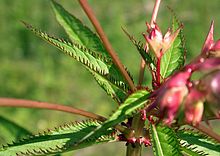“A herbaceous plant not valued for use or beauty, growing wild and rank and regarded as cumbering the ground or hindering the growth of superior vegetation… Applied to a shrub or tree, especially to a large tree, on account of its abundance in a district… An unprofitable, troublesome, or noxious growth.”
The New shorter Oxford English dictionary on historical principles has noted about weeds.
Known to cause trouble, weeds have noted beneficial properties. On the other hand, weeds have caused problems for farmers, homeowners and site owners, weeds such as Japanese knotweed and Himalayan balsam are the main culprits.
For humans as well as animals, some weeds are poisonous, so it is vital to keep them under control.
In 2015, the news reported a weed that can burn skin and cause potential blindness.
Weeds can:
- undermine the structural integrity of a building,
- reduce the productivity of agriculture
- cause a fine
Undermine Structural Integrity
Many find it hard to imagine a simple weed that can cause harm to a structure, but many are surprised by what damage can be generated.
Plants that cause structural problems are Japanese knotweed, Himalayan balsam, English Ivy and Trees.
However, what can each do?
Japanese Knotweed
The Japanese knotweed is commonly found in urban areas, riverbanks and waste ground. They are common from April to October and are not reliant on shadowed areas; they do not stay in woodlands.
The knotweed has no barrier to growth; it will grow through structures such as tarmac and house flooring. 
If there are any gaps in materials, the knotweed will grow through; it can also create risks of flooding if leaves clog waterways.
From April to October, you can find weed growth; a tiny root (the size of your fingernail) can establish itself as a plant in just ten days.
It is recognised by its bamboo-like stem, white flowers (which are produced in autumn) and shovel-shaped leaves.
If you discover the plant on your property, contact a certified company that can handle invasive plants.
It is listed as the world’s worst invasive species.
Himalayan Balsam
Commonly found around waterways, ditches or damp meadows, Himalayan Balsam is an invasive plant which can project its seeds up to 4 meters up and down streams. The ability to germinate in one season and become established attracts bees due to its long pollen season; this is feared that insects will neglect native plants.
Not only does this plant spread and germinate quickly, but the leaves and roots of the Balsam can also cause blockage in rivers, so when there is a mass downpour, the water cannot use its original course. Nevertheless, the plant dies back in the winter, leaving river banks bare and unprotected, thus causing erosion and ground instability.
Hedera Helix (aka common ivy or English ivy).
English ivy is known for its thick evergreen foliage and aerial roots; this support system is what causes the most problems. Ivy is only a problem if you have pre-existing structural issues such as cracking in brick or mortar; this causes further structural damages as the plant grows into the cavities and roof spacing; its dense foliage hides defects in the fabric of the building and can hinder maintenance work. This climbing plant may look pretty on your building, but what it causes is not.
It is suggested that ivy is a cause of dampness in the building following downpours; the through is the vegetation slows down the drying process.
This is true of southwest-facing walls where winds drive the rain. Nevertheless, it is noted that North and East facing barriers, the evergreen ivy causes slight drying on the mortar and can provide a degree of insulation in winter.
If the ivy is controlled correctly and all masonry faults corrected, this plant should not have problems.
The primary key is to keep the growth away from gutters, windows, doors and paintwork.
Ensure that unwanted pests may take refuge in the shelter caused by the ivy, causing other problems.
Trees
 Trees can range in height and width, no matter where you plant them; remember, the tree is as big underground as it is with its canopy.
Trees can range in height and width, no matter where you plant them; remember, the tree is as big underground as it is with its canopy.
At the point of maturity, a tree will show any problems with the structure.
If the canopy is close, then roots will also be.
Roots of trees will not move for your utilities. They don’t just interrupt your water supply and sewage removal. They can cause literal movement causing the building to lose its sound structure. The exact science used to understand a swelling door can also apply to a living tree; this causes the instability of the groundwork. If the foundation is not equipped for such movement, the house will show signs of subsidence. Correcting this matter is extensive and expensive.
Reduce the productivity of agriculture
Plants that are unwanted and unintentionally grown are known as weeds; these plants affect the growth of crops (purposefully grown plants) by taking space, light and nurturance out of the ground, reducing the number of the crop plant.
Some plants are hazardous to farm animals and humans, but if a weed is not poisonous and does not affect necessary plant growth, farmers will leave them to grow as food for all animals.
What weed can cause a fine?
For more information on the prevention of the spread of harmful invasive and non-native plants click here.
Are there any benefits from weeds?
The term “weed” has a negative association; many plants, commonly known as weeds, have beneficial properties.
In nature, no plant is a “weed”.
Weeds are used for food or herbal medicine; by using their root or leaves, such as the lamb’s quarter and dandelion. Weeds in East Asia are made into soup and medicine; Burdock is common over much of the world.
The main benefit to weeds is that they are plants, and all have learnt in school plants help produce oxygen. Once a weed has died, it decomposes rejuvenating the soil it grew from, returning nurturance into the ground.
Weeds may act as “living mulch”, providing ground cover that reduces moisture loss and prevents erosion. Weeds may also improve soil fertility; for example, dandelions bring up nutrients like calcium and nitrogen from deep in the soil with their taproot, and clover hosts nitrogen-fixing bacteria in its roots, fertilising the ground directly. Some ‘weeds’ are beneficial for attracting certain insects, which protect crops from harmful pests. Weeds can also prevent pest insects from finding a crop.
Common weed in European wheat fields, corncockle are sometimes grown as a garden plant; like many other weed type plants. Some farmlands weeds are permitted, but why is this? In the right place, in the right quantity weeds like docks with their broad-leaves can be beneficial for birds and insects.
Interesting fact Japanese’s Knotweed – a sprout can be eaten in stews; the taste is likened to sour rhubarb.
Himalayan Balsam is also edible such as the green seedpods, seeds, young leaves and shoots and the flowers are suitable for jam or parfait.














